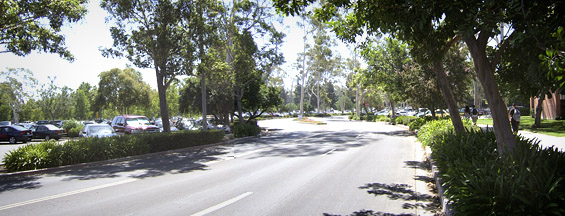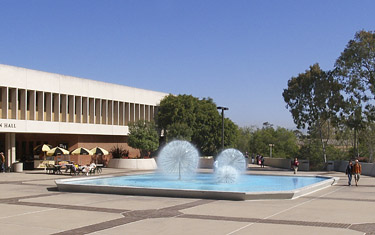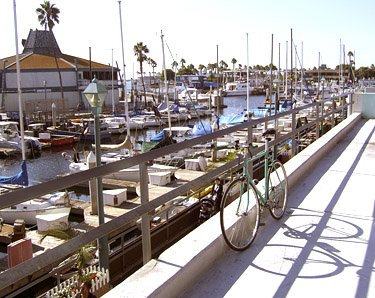The cliché is that Los Angeles has forgettable architecture and beautiful people, but that's not really true. There are plenty of stunning buildings of every style scattered around, as well as neighborhoods that are both charming and lively (though not often at the same time) breaking up the bleak stucco-tinted light. At the same time, there is no dearth of plug-uglies here, I assure you--I'm one of them myself! But the ride I took last Tuesday supported the clichés, and not the exceptions to the rule.
It's not often I am free during the week, so I decided to ride to where my dear wife Gina works, way down in Long Beach at the California State University, and meet her and her colleagues for lunch. Gina is one of the Beautiful People of Los Angeles, tall, slim, and graceful, a veritable Venus who doesn't believe it of herself but turns heads wherever she goes. How she ended up with me, I'll never figure, but I ain't complaining.

Alameda Street
I love the place. I do understand that it's not everyone's cup of tea, though. But I was riding alone. So after getting my morning chores done and laying on some sunblock, I saddled up the old Fuji fixed gear and headed east through Koreatown to the city center. A quick jog south at the Staples Center, then east again on Washington, running alongside the Blue Line trains which run in the street at that point, past Trade Tech College and finally to Alaemda Street, the main artery of the iron heart of LA. I headed south through the aforementioned landscape, enjoying the grumble of commerce and the accidental sculpture of cranes, conveyors, silos, tracks, and hoppers, of compressor arrays and powerlines, of concrete cliffs and sprawls of glittering metal. Southward, ever southward, through Vernon and Industry, cities with resident populations in the low hundreds but into which pour tens of thousands of workers and artisans each weekday; through Lynwood and into Watts, as far as Firestone Boulevard--a street named after an old tire factory. I jogged east on Firestone to Long Beach Boulevard, which would take me through Compton to Long Beach itself.
Now I know what you're all thinking: Omigod, he's bicycling through Compton! Is he nuts?.
Well, I am nuts, but that's not proof of it. Last time I rode through Compton, the most arresting sight I saw was an old Hispanic couple riding their horses down the lane, hand in hand...there's a lot more to Compton than Willowbrook avenue and hardcore rappers (one of whom is a web client of mine. Compton has its problems--not just gangs but an often corrupt city administration (a trouble is shares with the City of Industry earlier on my route), but it's not all hell on earth. Much of it is multiracial, with a lot of Latino and even some white folks along with the majority black population. Much of it has undergone a commercial renaissance since the construction of the Blue LIne light rail line through town some 12 years ago. The people in East Compton, where I was riding now, were the most polite on the road of any I encountered on the ride, and far nicer to this old white bicyclist than the folks I encounter in my daily commute through upscale West Hollywood and Hancock Park.
At one point I heard the roar of a hopped-up engine behind me as I came to a red light. Looking back, I saw a primer-painted Vega with drag slicks on the back wheels, looking like he wanted to turn right. As I usually do, I rolled a foot or left to give him room. As he rumbled by, the young black man inside gave me a nod, a wave, and a gentle smile, then roared west on Compton Boulevard, trailing echoes of his straight pipes and subwoofer for blocks as he drove.
The architecture was unutterably banal, as it would be in most of Long Beach--generic dark beige malls and chain diners for the most part--but the streets were full of relaxed people of all ages and colors, walking along or riding those sad department-store mountainbikes or '70s bike boom relics common among the poor in America.

California State University,Long Beach

Fountain at CSULB

The Los Angeles River Estuary
Ah, PCH, road of legend: Malibu, Santa Monica, Redondo Beach, surfers and bikinis and sun and blue water...but not here. Here it is a dreary hybrid between street and freeway, feeding truck traffic to the refineries and concrete plants and scrap yards and what have you, arching over railyard after railyard on bleak white concrete bridges that reflected the white sky back in my face and concentrated the sea wind at their crests, just where I would be most tired from pulling the hill.... The landscape of cracking towers, oil tanks, and acres of waiting trucks was broken only by the occasional generic roadside mall, with the usual chiropractors and dentists, small dress shops and computer outlets. I was weary now, fighting the wind and the heat, as it was in the nineties, and after what seemed like several centuries of riding spotted an honest-to-god liquor store where I grabbed a Gatorade and chugged it down. I had left Satchmo, my Fuji fixie, in the store, and when I came back to get him, the clerk was admiring his lugged-steel lines. He asked me how far I'd ridden so far. When I told him, his eyes bugged out of his head. Why?, he asked. Did I need to exercise? "Just out seeing the world," I told him. And it was true.
The next leg of PCH took me between the flat south end of Torrance and the green-clad hills of Palos Verdes, much pleasanter, and soon I was at the beach.

Satchmo resting at Kings Harbor
It was later afternoon by then, and the light was golden. I saddled up, zipped refreshed along the bikepath that follows Ballona Creek inland to the eastern border of Culver City, came back out onto the streets a few miles from home, and spun northeastward with visions of hot showers dancing in my head.
Around 80 miles on the fixie, and a day well-spent. And Venus waiting for me when I got back home.
Text and photos by Richard Risemberg
Photo of the Dandelion Fountain at CSULB by Gina Morey

